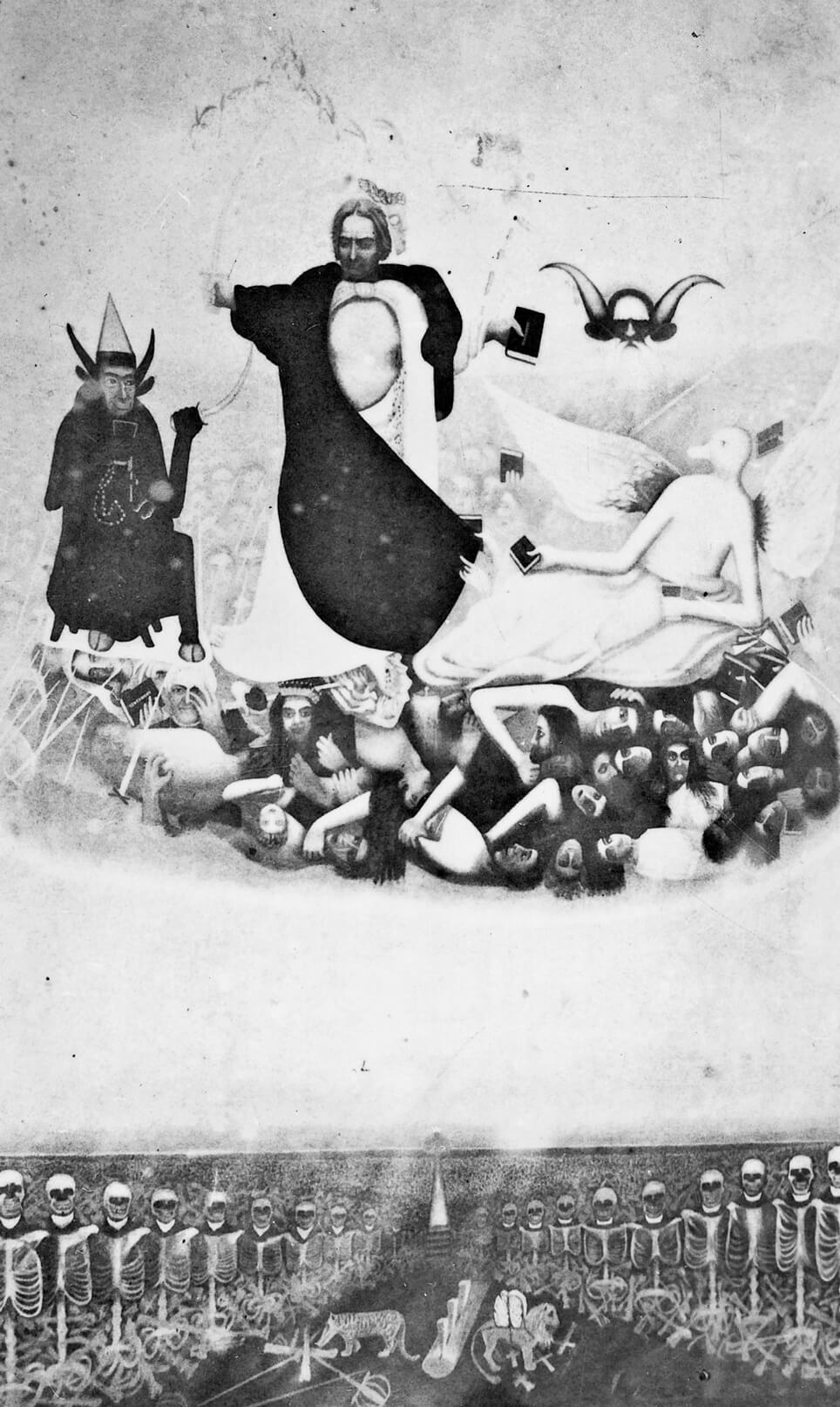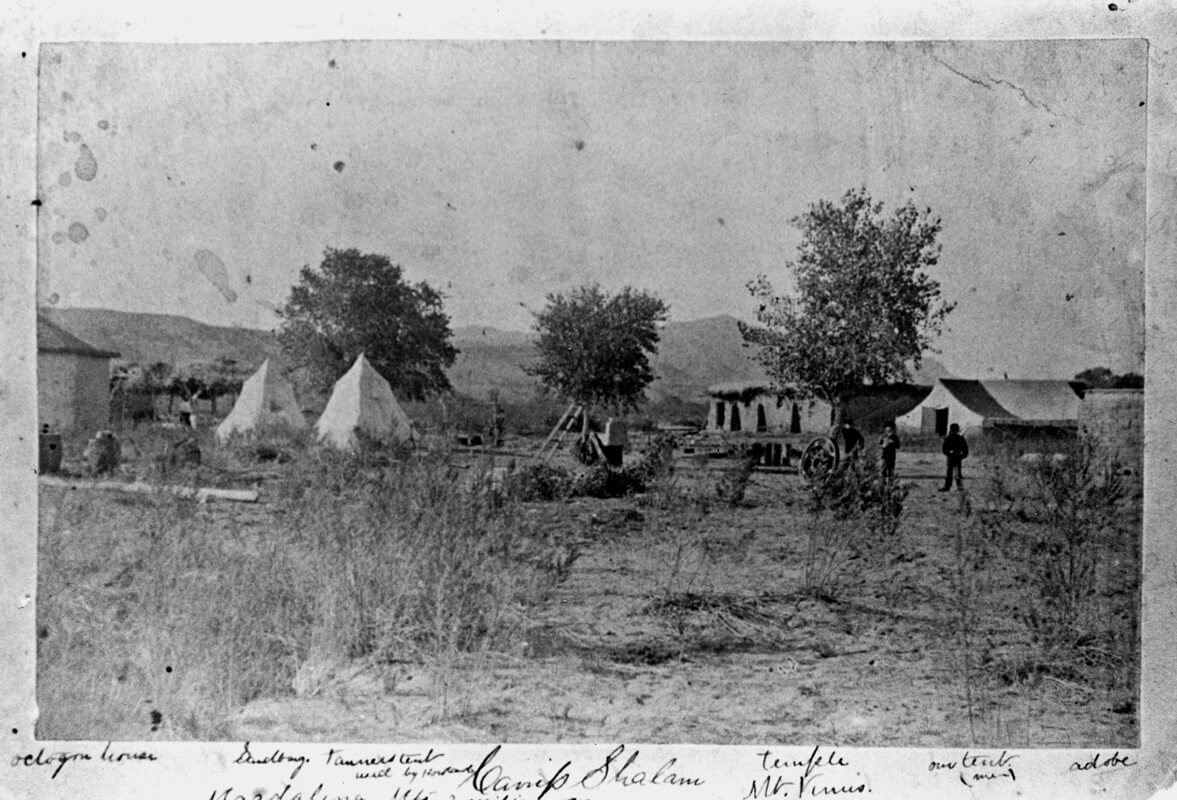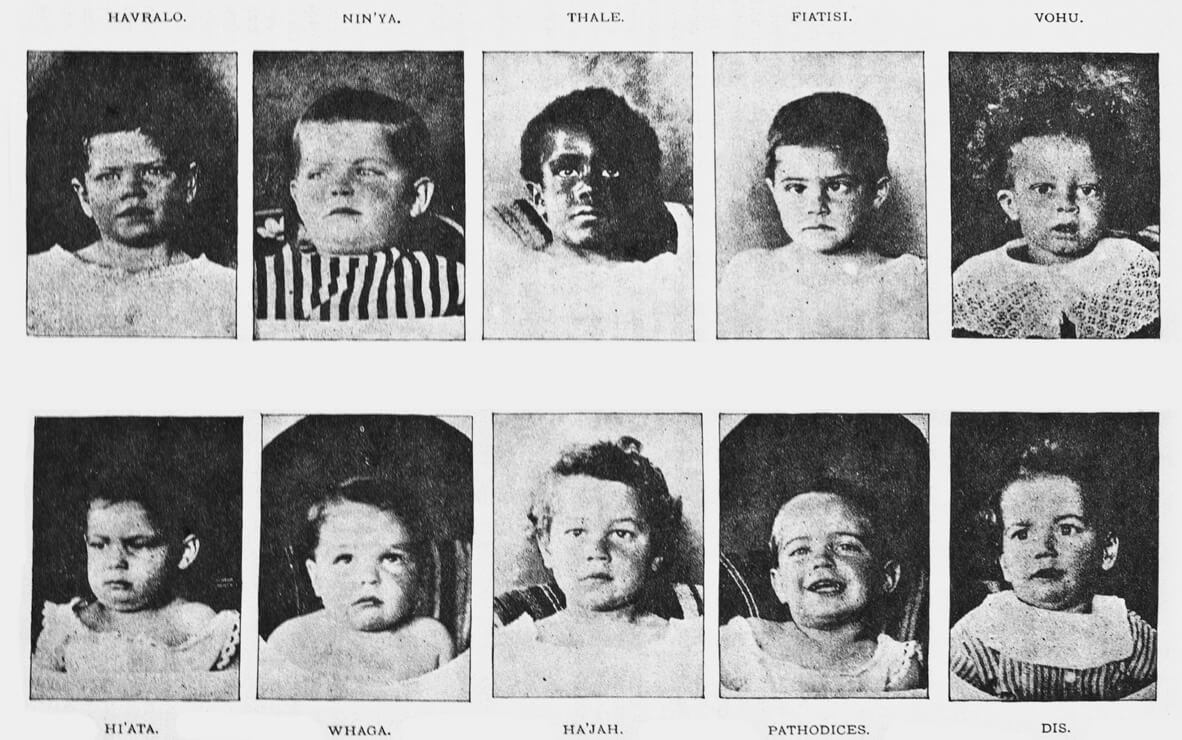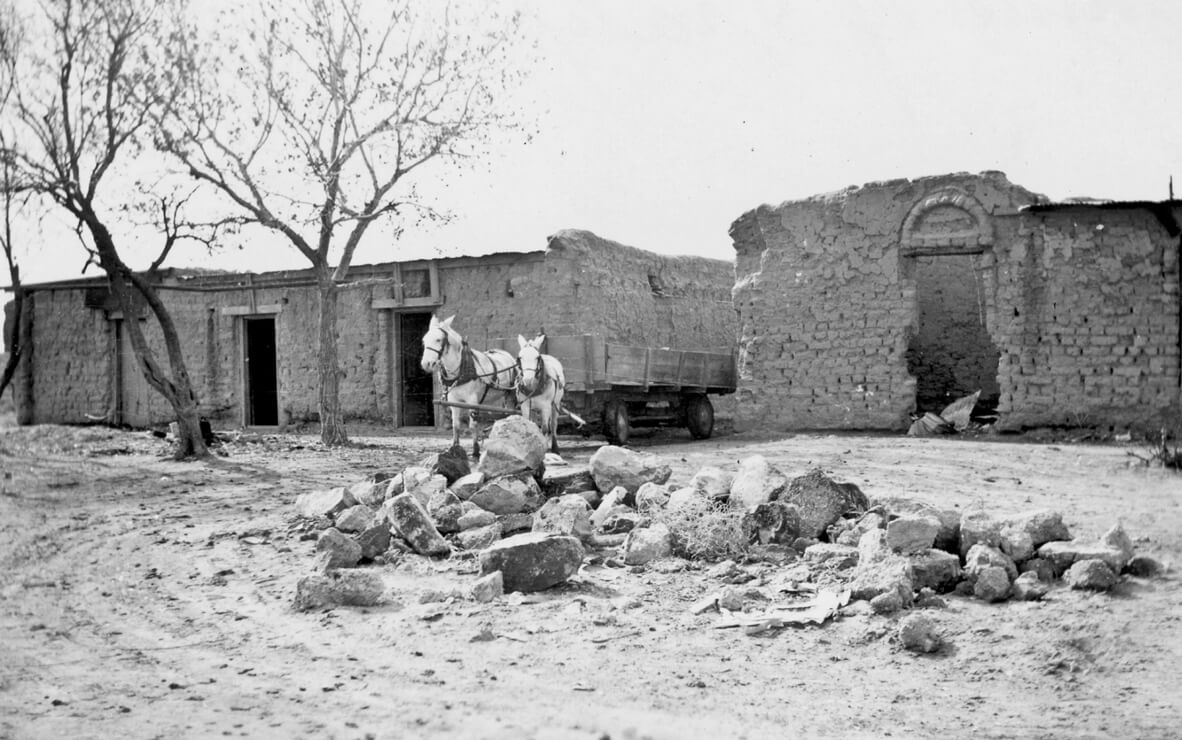Orphan Utopia
John Ballou Newbrough’s desert colony
Reed McConnell

When the angels appeared to John Ballou Newbrough early one morning in 1881, he was nothing if not well prepared. A dentist and Spiritualist, he had spent the last ten years purifying himself for supernatural contact by abstaining from meat, bathing twice a day, and rising before dawn. The visit was expected.
The angels wanted him to buy a typewriter, a newfangled device—Newbrough described typing as writing “by keys, like a piano” in a letter to the Boston Spiritualist journal The Banner of Light—that would allow him to transcribe their account of the world’s true spiritual history.[1] He obeyed, and for the next fifty weeks the angels visited him in his New York City apartment every morning before sunrise, taking control of his hands in sessions that lasted exactly fifteen minutes. By the end, Newbrough had produced a nine-hundred page manuscript called Oahspe: a history of world religions that exposed their lies and elucidated their fundamental interconnections.[2]
The dictating angels were nothing if not thorough. To supplement the text, they provided Newbrough with images of religious leaders, which he painted in the dark. Among those reproduced in the 1891 edition of Oahspe are the austere, mustachioed Zarathustra, with a cherub grinning behind his left shoulder, and a serenely smiling Confucius, hair stroked by a ghostly figure while an enormous eye floats in the clouds above him. These luminaries appear alongside diagrams and illustrations, everything from language trees to astronomical models to illustrations of ancient temples. (Newbrough claimed to have copied them, according to the angels’ instructions, from technical books.)

Although Spiritualism was known and largely accepted in the New York of the time—séances were popular among the rich, and Newbrough had been hosting them in his apartment on West 34th Street for decades—some quarters received Oahspe with hostility. A “new bible” was a bit harder to reconcile with Christianity than simple communication with spirits, especially when that bible claimed that Jesus was actually a crafty angel named Looeamong who had tricked the other angels and minor deities into electing him chief divinity of the universe. A New York Times article from 1883 describes an interaction between Newbrough and a heckler at an early meeting introducing Oahspe:
Dr. Newbrough: You are out of order. We do not open discussion.
Mr. Lightburn: Do you wish the Old Bible to be thrown aside? If Christianity is not true I want to know what is.
Dr. Newbrough: You are out of order, Sir.
Mr. Lightburn: Of course I am. Everybody is. You had no right to make such announcements if you cannot substantiate them. Give me my hat.[3]
What most fascinated the newspapers, though, was Newbrough’s intention to found a colony. Oahspe enjoins its followers—called Faithists—to gather orphans and raise them to be independent, vegetarian, and spiritually pure, as preparation for leadership of a New World Order. The New York Times reported that “all that was asked of the members was that they should buy tracts of land in order that head-quarters might be established and people removed to them from the profanity of the world,” and at the time of the article’s publication, the search was already underway for a site in the southwestern desert.[4] Shalam, as Newbrough ultimately named the colony, would be a religious community and a refuge for thousands of indigent babies, far from the corruption of cities. As they prepared to leave a year later, the New York Times reassessed the colonists’ aims: “[the Faithists] have given no intelligible idea of what they want or seek to accomplish.”[5]
• • •
Newbrough actually had a very clear sense of what he sought to accomplish. The bedrock of his venture was his concern for the destitute, a fixation with roots in his early life. Born in rural Ohio in 1828, he witnessed the health consequences of poverty while working as an assistant to a dentist in Cleveland during his high school years. After graduating, he attended medical school and finally became a dentist himself, moving to New York with the goal of tending to the oft-neglected dental problems of the urban poor. He then traveled the world, making a fortune in the California gold rush before traversing Europe and Asia. His journeys gave him a pronounced sense of poverty’s misery, and compounded his determination to do something about it.[6]
Newbrough’s obsession with babies (or babes, as he called them) has less obvious sources. But its ramifications are evident in every aspect of his new faith. The section of Oahspe that warns against theft focuses not on food or livestock but babies: “Now, behold, a certain rich man coveted his neighbors’ children, and he went about and captured many of them. And withal he was mighty above his neighbors, and none of them could regain their offspring.”[7] Oahspe also prohibits abortion, referring to aborted fetuses as babies “slain by their mothers and fathers.”[8] Newbrough’s passion for babies was not limited to those in almshouses—it seems that he wanted as many as possible to come into being.
“I wish I were where ten thousand babies fenced me in on every side,” wrote Newbrough to a friend in 1883, the year before he arrived in New Mexico and established Shalam.[9] In a subsequent letter, he describes the living conditions in orphanages that made his efforts to acquire babies for the colony so urgent:
We lost one little babe, which we brought away from the almshouse—though it was nearly dead when we received it . . . To me it is perfectly appalling how these little things are slaughtered in this city. We hope to save many, and to raise them up in the right way, so as to have a new race by and by.[10]
Surprisingly, Newbrough’s conception of a “new race” was free from the scientific racism then prevalent. At a time when eugenicist notions of racial purity were ascendant in American society, Newbrough took in all the babies he could get ahold of—baby boys and baby girls of any race and class. However, the number of babies he was able to bring to Shalam was not high. Few of the settlers entering the colony already had children, and bureaucratic hurdles made it hard for Newbrough to adopt.[11] In a letter of 1883, Newbrough writes that “there is so much round about red tapism to be gone through in order to get a child out, that it dies by the time the permit is granted.”[12] A Southwestern Farm and Orchard profile of Shalam written ten years after its establishment counts only twelve babies living there, “among them … a negro and at least one mulatto.”[13] Before the colony’s demise, the Faithists also adopted a baby of Chinese descent.[14] The children had one thing in common: all had been orphaned, and most were among the poorest of the poor. Such were the children that John Ballou Newbrough hoped would inherit the earth.
• • •
The search for a place to start the colony took some time. Newbrough looked in California, but his attempts to acquire land there fell through. Returning from an exploratory trip, he stopped in Las Cruces, New Mexico, and there found many acres of arid land available very cheaply. The colonists pitched their first tents in late October 1884.[15]
Shalam’s colonists knew almost nothing about farming, and their first months in Mesilla Valley were hard. Growing vegetables in the unirrigated desert was a monumental task, and the Faithists, who adhered to a vegetarian diet, suffered. There were no buildings on the land—the construction of dormitories, kitchens, and a school began a year later—and the villagers had to spend the first few months living in tents. But with the indispensable aid of villagers from Doña Ana, just south of the colony, Shalam ultimately built an irrigation system: sixteen miles of piping and a seventeen-thousand gallon reservoir.[16] People from Doña Ana also taught the colonists how to cook beans and chilies, and worked on the commune when the Faithists were overwhelmed. Within a few years, Newbrough and his partner in the venture, Andrew Howland, were supervising a (mostly) self-sustaining commune.
But Shalam remained small, and so, despite a lack of emphasis on proselytizing, Newbrough and his wife began to travel the country on baby-collecting missions. In New Orleans, where they spent several months, the Newbroughs established a “receiving home” with the slogan “Children Wanted and No Questions Asked.” Other Faithists established similar homes in Kansas City, Chicago, and Philadelphia.[17]
The 1894 Farm and Orchard profile of the colony described the twelve children on the farm as “mostly about 8 years of age . . . fed entirely on vegetable food, with a liberal allowance of fruit and nuts. Their clothing consists of a little linen tunic, and they wear no hats or shoes. They receive a bath twice a day.”[18] The adults, too, wore little: in “Shalam: Utopian Desert Paradise,” Ann Hufstedler writes that “Shalam was considered by some to be practically a nudist colony, as the men worked in the fields in white trousers, barefooted, bareheaded, and shirtless. Their long hair would naturally add to their unusual appearance. Howland was once arrested in El Paso, Texas, for indecent appearance.”[19]

Although the commune’s children were raised in a highly ascetic environment, Farm and Orchard observed that they appeared healthy (“although not robust”), also remarking “one note-worthy fact about them. We have made several visits to the colony and never saw one of the children crying or looking unhappy. They are always running about at play and they are the most cheerfully obedient lot of children we ever came across.”[20]
• • •
Tensions abounded, however, among Shalam’s adults. Communal labor was difficult; irrigation ditches had to be dug, vegetables had to be harvested, and while members of the colony did not pay for room or board, they also received no wages—which made transitioning back into life outside an exceedingly difficult prospect.

In 1891, a man named Jesse M. Ellis claimed to have been deceived by the colony, and sued. His case made it to the New Mexico Supreme Court, which ruled in favor of Shalam. Justice A. A. Freeman’s decision is written in such florid prose that it has raised speculation that he was inebriated when he wrote it. He makes fun of both the plaintiff and Oahspe:
The most that can be gathered from the declaration is that the defendants . . . had christened [their] newfound Vale of Tempe the “Land of Shalam:” had sent forth their siren notes, which, sweeter and more seductive than the music that led the intrepid Odysseus to the Isle of Calypso, reached the ears of the plaintiff at his far-off home in Georgia, and induced him to “consecrate his life and labors, and all his worldly effects,” etc., to the new gospel of Oahspe.[22]
Freeman proceeds to scrutinize one of the central stories in Oahspe (the book was entered as evidence) in which the world’s deities gather to elect a god to be worshipped above all others—essentially, their president. It’s quite an assembly: Buddha attends, as do Mars, Jove, and Shiva. Thirty-seven candidates vie for the position of supreme god, of whom only fifteen are listed. The names of the remaining twenty-two, the judge remarks, “are not given, and, therefore, there is nothing in the record to support the contention of the counsel that the list includes the names of Bob Ingersoll and Phoebe Coussins [sic].”[23] Supernatural deliberations continue for one year and five months, after which the exhausted deities let the lower angels make the decision—handy for Christ, or “Looeamong,” head of the lower angels. He is elected unanimously, which seems to have bothered Justice Freeman:
We think this part of the exhibit ought to have been excluded from the jury, because it is an attack in a collateral way on the title of this man Looeamong, who is not a party to this proceeding, showing that he had not only packed the convention (council) with his friends, but had surrounded the place of meeting with his hosts, ‘a thousand angels deep on every side,’ thus violating that principle of our laws which forbids the use of troops at the polls.[24]
• • •
Jesse Ellis may have been the first former member of Shalam to publicly express discontent with the colony, but the years after the verdict in his case were tumultuous. In 1891, Newbrough died in an influenza epidemic; Andrew Howland married his widow and assumed leadership.[25] Howland created a sister colony called Levitica on the same tract as Shalam, consisting of twenty houses, each with their own acre of land, set aside for full families who wished to join the commune. But after many of the families in Levitica refused to do the work necessary for its upkeep, Howland dissolved it, chartering a train for the emigrants.[26]
Mooching was a problem that Shalam, like many other utopian communities, was unable to avoid. Though some were drawn to New Mexico by the opportunity to work in harmony with like-minded, determined individuals, others exploited the colony’s resources. And while Faithist boosters predicted that Shalam would eventually adopt two to three thousand babies, the number of children adopted never rose above twenty-eight.[27] In a July 1970 article in the New Mexico Historical Review, Daniel Simundson suggests that the colony’s failure was mostly a consequence of insufficient human and financial capital: “Its labor force was inadequate. Newbrough’s band was largely comprised of romanticists and amateur metaphysicians who had little aptitude for physical labor. Finally, although the Oasphe[sic] bible had indicated that converts would be inevitable, they never appeared.”[28] The lack of adequate labor force was then compounded by the loss of financial backing: over the course of his involvement with Shalam, Andrew Howland had sunk his entire fortune into colony upkeep and unprofitable agricultural ventures, and by 1900, he was reduced to selling cookies called “U-Like-Ums” door-to-door in the neighboring village of Doña Ana as a last-ditch attempt to support Shalam’s two dozen children.
The colony dissolved in 1901. Howland, who had put the deed to the colony in the name of the children, successfully sued to have it transferred back to his own name,[29] and sent them off to foster homes and orphanages—a heartbreaking development for a group of children who had, by all accounts, had a loving upbringing.[30] Shalam might have “failed,” but for seventeen years it provided twenty-eight orphans with a safe and happy home.
• • •
Shalam has left only traces in the Las Cruces of today. The colony’s former campus is now owned by farmers, and where there were once fields and houses and babes there are now acres of trees planted in straight rows. The dry and unforgiving land that once gave the Faithists so much trouble is now used entirely for pecan farming.
The colony’s most enduring legacy is religious, or ideological, rather than physical, and in fact the movement never died out. But its numbers have remained static. Unlike Mormons, for instance, Faithists do not aggressively proselytize, instead quietly waiting for people to join them of their own accord, or else sending out friendly pamphlets. After the dissolution of Shalam Colony, believers continued to pass the faith on to their children and the very occasional convert, and new communities were steadily established in locations ranging from Arizona to as far east as Massachusetts.
In the 1950s, a directory of religious organization listed a Faithist group called the Essenes of Kosmon operating a colony in Montrose, Colorado: “In May, 1954, the group included eight people, four men, two women, and two children. New members are desired. The requirement for membership is to know Oahspe and follow its teachings. A year of probationary residence is required before acceptance as a resident member.”[31] Archived newsletters from the group indicate that its numbers never grew beyond ten.[32] For a while, a Faithist named Virginia Howard operated a very small commune in Tiger, Georgia, but she passed away in 2010, and the colony with her. There have been no active colonies for several years.
• • •
The age of the frontier is over. In Wasted Lives, the philosopher Zygmunt Bauman writes that “the planet is full,” and that this “signals the disappearance of ‘no man’s lands,’ territories fit to be defined and/or treated as void of human habitation as well as devoid of sovereign administration—and thus open to (clamouring for!) colonization and settlement.”[33] We are as a world now awake to the inhabited nature of most livable space. The world is devoid of perceptible voids, places where one might imagine starting with a blank slate because the place itself is understood as a blank slate.
But place was always incidental to Shalam Colony. Newbrough chose the New Mexican desert not because it had sacred significance (as was the case for Mormon settlers in Utah), but because it allowed the Faithists to establish a community removed from the dictates of the outside world. A provision in Oahspe instructs Faithists that when they erect buildings in their communities, they should never be built to last, because each generation should have the chance to build something new, with their own hands: “Man buildeth a house, and it perisheth. Succeeding generations must also build, otherwise the art of building would perish. Better the building perish, than the art of building.”[34] The community, in any given iteration, is not supposed to last forever. What matters is that the ideas and the passions of the Faithists live on.
There are about twelve practicing Faithists remaining in the world, scattered from Japan to New Mexico to Massachusetts.[35] They keep in touch electronically, holding weekly prayer meetings via Skype. The Internet is perhaps the closest thing to a frontier that exists today—a placeless space where our dreams of a better world can imprint themselves upon the endless, neutral network. Failing that, the next frontier is space. And on that score, Oahspe was ahead of its time. Although it was written in the late 1800s, the book dreams of spacecraft, of visitors from other worlds floating down to earth in “etherean ships.”[36] Heaven’s reaches are boundless, and who knows what humanity might discover as it continues to traverse them: new planets, new stars, or benevolent new gods entirely concerned with children, with their health and well-being, and the opportunity for every one of them to flourish.
- Cited in “John Ballou Newbrough,” in The Encyclopedia of Occultism and Parapsychology, vol. 2, 2nd ed., ed. Leslie A. Shepard (Detroit: Gale Research Company, 1984), pp. 950–951.
- Ibid.
- “Faithists in Convention: Delegates from Eleven States at the First Session,” The New York Times, 25 November 1883.
- Ibid.
- “The Sect of Faithists: The Followers of Oahspe and Some of the Plans and Practices,” The New York Times, 21 November 1884.
- Lee Priestley, Shalam: Utopia on the Rio Grande (El Paso: Texas Western Press, 1988), pp. 5–7.
- John Ballou Newbrough, Oahspe: A New Bible in the Words of Jehovih and His Angel Embassadors (New York: Oahspe Publishing Association, 1882), p. 804.
- Ibid., p. 207.
- John Ballou Newbrough to Mr. and Mrs. Arthur Bates, 6 April 1883. Opal Lee Priestley Papers, Archives and Special Collections, New Mexico State University Library.
- John Ballou Newbrough to Mr. and Mrs. Arthur Bates, 26 April 1883. Opal Lee Priestley Papers, Archives and Special Collections, New Mexico State University Library.
- The Faithists sometimes mailed proselytizing literature directly to children. In 1885, one Atlanta paper reported sightings of a Faithist book that had “the appearance of an almanac, and thereby slips through the hands of watchful parents. Within the past few days, however, several of them have fallen into fathers’ hands and as many complaints have been made to Postmaster Wilson.” See “Fathers Get Mad: Because Their Children Receive a Book. A Pamphlet Mailed to Atlanta Children Creates Sensation—The Inducements Offered to Live in Shalam—The Religious Belief of the People Who Live There, Etc., Etc.,” The Atlanta Constitution, 1 October 1885.
- John Ballou Newbrough to Mr. and Mrs. Arthur Bates, 6 April 1883.
- “The Shalamites,” Southwestern Farm and Orchard, vol. 1, no. 7 (September 1894), p. 1.
- Lee Priestley mentions that “a Chinese child found a private home” after the dissolution of the colony. See Priestley, “Shalam: Land of the Children,” New Mexico Magazine, vol. 39, no. 6 (November–December 1961), p. 46.
- Ibid, p. 22.
- Ibid, p. 23.
- Ibid, p. 22.
- “The Shalamites,” Southwestern Farm and Orchard, p. 1.
- Ann Hufstedler, “Shalam: Utopian Desert Paradise,” Las Cruces Citizen, 28 April 1960. Hufstedler was a senior at Las Cruces High School. Her essay won first place in the Katherine D. Stoes section of a student writing contest hosted by the Las Cruces Writers’ Club and was subsequently published in the Citizen. Stoes was one of the first journalists to research and publish significant work on Shalam Colony, and her papers reside at New Mexico State University. The footnotes and bibliography of Hufstedler’s article were not printed in the newspaper.
- “The Shalamites,” Southwestern Farm and Orchard, p. 1.
- “The higher court’s decision was couched in terms which still are rated as the most scintillating example of juristic humor extant in any language—so unusual in legal proceedings that snickering lawyers now suggest that Justice Alfred A. Freeman, who wrote it, must have been inspired by spirits of the liquid variety.” Wallace Perry, “The Glorious Land of Shalam,” Southwest Review, vol. 38, no. 1 (Winter 1953), p. 40.
- Ellis v. Newbrough, 1891-NMSC-028, 6 N.M. 181, 27 P. 490 (S. Ct. 1891), p. 2. Page number refers to the digital version of the decision available at http://nmcompcomm.us/nmcases/NMSC/1891/1891-NMSC-028.pdf [link defunct—Eds.].
- Ibid. Bob Ingersoll and Phoebe Couzins were both prominent lawyers in the late 1800s, he an orator famous for his defense of agnosticism and she one of the first female lawyers in the country. It is likely that someone involved in the suit made a joke about the list of candidates being so long that it probably included the names of famous legal figures like Ingersoll and Couzins, and the judge is taking this at face value, whether tongue-in-cheek or not.
- Ibid.
- Lee Priestley, “Shalam: Land of the Children,” p. 23.
- Ibid.
- See “Fathers Get Mad” for the Faithists’ optimistic estimates, and Wallace Perry, “The Glorious Land of Shalam,” p. 43, for details on the number of orphans adopted by the colony.
- Daniel Simundson, “Strangers in the Valley: The Rio Grande Republican and Shalam, 1884–1891,” New Mexico Historical Review, vol. 45, no. 3 (July 1970), pp. 205–206.
- “End of the Shalam Colony,” New-York Tribune, 27 April 1901.
- See Ann Hufstedler, “Shalam: Utopian Desert Paradise,” and also Lee Priestley’s “Shalam: Land of the Children,” p. 46. Priestley claims that a black child from the colony was sent to live with Booker T. Washington after its dissolution. However, it is impossible to locate the source for this dubious claim.
- Directory of communes, n. d., folder 10 (“A Survey of Mutualistic Communities in America”), Opal Lee Priestley Papers, Archives and Special Collections, New Mexico State University Library.
- “A Friendly Talk,” The Kosmon Pioneer Bulletin, vol. 9, no. 8 (August 1951), pp. 3–4.
- Zygmunt Bauman, Wasted Lives (Cambridge, UK: Polity Press, 2004), p. 5.
- John Ballou Newbrough, Oahspe, p. 290.
- Interview with a Faithist, 11 November 2015.
- John Ballou Newbrough, Oahspe, p. 55.
Reed McConnell is a writer interested in environmental contamination and the American Southwest. She studies cultural history and theory at Humboldt University in Berlin.
Spotted an error? Email us at corrections at cabinetmagazine dot org.
If you’ve enjoyed the free articles that we offer on our site, please consider subscribing to our nonprofit magazine. You get twelve online issues and unlimited access to all our archives.